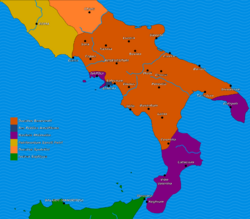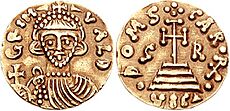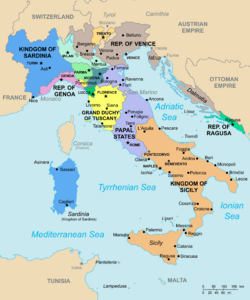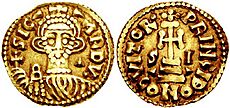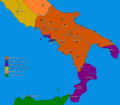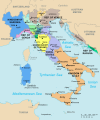Duchy of Benevento facts for kids
Quick facts for kids
Duchy (Principality) of Benevento
Ducatus (Principatus) Beneventi (Latin)
|
|||||||||||
|---|---|---|---|---|---|---|---|---|---|---|---|
| 577–1053 | |||||||||||
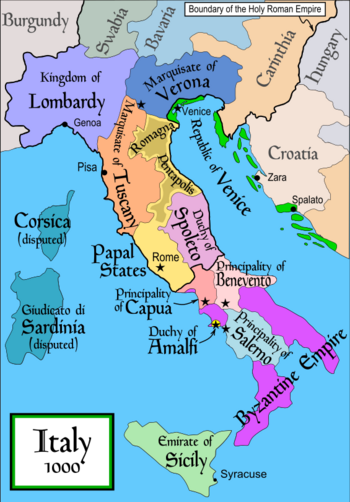
The Principality of Benevento
shown within Italy in 1000 |
|||||||||||
| Status | Vassal state of the Kingdom of the Lombards | ||||||||||
| Capital | Benevento | ||||||||||
| Common languages |
|
||||||||||
| Religion | Chalcedonian Christianity (official), Arianism (former) | ||||||||||
| Government | Monarchy | ||||||||||
| Duke / Prince | |||||||||||
|
• 571–591
|
Zotto (first duke) | ||||||||||
|
• 774–787
|
Arechis II (last duke & first prince) | ||||||||||
|
• 1059–1077
|
Landulf VI (last prince) | ||||||||||
| History | |||||||||||
|
• Established
|
577 | ||||||||||
|
• Frankish conquest of the Kingdom of the Lombards
|
774 | ||||||||||
|
• Disestablished (Norman conquest of southern Italy)
|
1053 | ||||||||||
| Currency | Solidus, tremissis, denarius | ||||||||||
|
|||||||||||
| Today part of | Italy | ||||||||||
The Duchy of Benevento was an important area in Southern Italy. It was ruled by the Lombards, a Germanic people, for a very long time. From 571 to 774, it was called a Duchy. After 774, it became known as the Principality of Benevento.
The city of Benevento was its main center. This area was almost always independent. This was because it was cut off from the main Lombard kingdom in the north by lands controlled by the pope. The Normans eventually conquered Benevento in 1053.
Starting the Duchy
Historians aren't completely sure when the Duchy of Benevento began. Some believe Lombards were in southern Italy as early as 571. Others think they arrived around 590.
The first ruler was a military leader named Zotto. He led a group of soldiers down the coast of Campania. At first, Zotto was independent. But later, he accepted the rule of the Lombard king in the north. After Zotto, his nephew Arechis took over. From then on, rulers were usually chosen by family inheritance.
The Lombard duchies, like Benevento, were mostly independent. This was true even though they shared a common background, language, and laws with the northern kingdom. A large area controlled by Rome or Ravenna separated Benevento from the Lombard kings in Pavia.
Because of this separation, Benevento developed its own unique culture. For example, it had its own special church music called Beneventan chant. This music was used until the 11th century. A special way of writing Latin, called Beneventan script, also developed there.
A famous writer named Paul the Deacon lived in Benevento in the 8th century. He wrote important histories of Rome and the Lombards. His writings are a main source of information about the duchy during that time.
Growing Stronger
Under Zotto's successors, the Duchy of Benevento grew by taking land from the Byzantine Empire. Arechis, for example, captured Capua and Crotone. He also attacked Amalfi, but he could not capture Naples.
After his rule, the Byzantine Empire held only a few places in southern Italy. These included Naples, Amalfi, Gaeta, Sorrento, Calabria, and some coastal cities in Apulia.
In 662, Duke Grimoald I went north to help the Lombard King Godepert. Instead, Grimoald became king himself. As king, he tried to bring back Arianism, an older Christian belief. But Arianism was already fading away, even in Benevento.
In 663, the Byzantine Emperor Constans II tried to take back southern Italy. He attacked Benevento. But Duke Romuald I bravely defended the city. The Emperor eventually left. Romuald even defeated part of the Roman army near Forino. A peace agreement was signed between Benevento and the Byzantine Empire in 680.
In the years that followed, Benevento continued to gain land from the Byzantines. But the main enemy of the duchy became the northern Lombard kingdom itself. Kings like Liutprand often tried to control who ruled Benevento.
A Second Capital
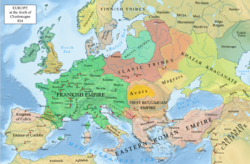
In 758, the Lombard King Desiderius briefly took control of Benevento. But in 774, Charlemagne conquered the northern Lombard kingdom. After this, Arechis II of Benevento wanted to become a king himself. He hoped to make Benevento a "second Pavia" (Pavia was the old Lombard capital).
However, Arechis realized this might make Charlemagne attack him. So, he chose the title of princeps (prince) instead. In 787, Charlemagne forced him to accept Frankish rule. Even so, a writer at the time called Benevento a "twin Pavia."
Arechis made the city of Benevento bigger. He built new walls and a new princely palace. Like the Byzantines, the dukes connected their palace to a main church, Saint Sophia.
In 788, Byzantine troops invaded Benevento. They were led by Desiderius's son, Adelchis. But Arechis's son, Grimoald III, stopped them. The Franks helped Grimoald, but they also attacked Benevento's lands several times.
Later, in 814, Grimoald IV made vague promises to pay tribute to Louis the Pious, Charlemagne's son. His successor, Sico, renewed these promises. But these pledges were not really followed. As the power of the Frankish rulers weakened, Benevento became more independent.
The dukes of Benevento used special seal rings to approve documents. This shows they continued some Roman ways of running their government. It also suggests that many people could read and write.
Decline and Division
In the next century, Benevento became very powerful. It even made Naples pay tribute and captured Amalfi under Duke Sicard. But in 839, Sicard was killed, and a civil war began.
Sicard's brother, Siconulf, became prince in Salerno. Meanwhile, the person who killed Sicard, Radelchis, took the throne in Benevento. After 10 years of fighting, Emperor Louis II stepped in. He decided to split the duchy into two separate areas: Benevento and the Principality of Salerno.
This crisis got worse because of attacks by Muslim groups. Both Radelchis and Siconulf had called on these groups for help during their war. The Muslims attacked Naples and Salerno, but they were not successful. A large Muslim settlement in southern Lazio was finally removed in 915.
At the same time, the Byzantine Empire started to take back parts of southern Italy. They recaptured Bari from the Muslims in 876. This further reduced Benevento's power.
In 899, Atenulf I of Capua conquered Benevento. He united the two duchies and said they should always stay together. He also started a rule where sons would share power with their fathers.
However, all of southern Italy was united one last time by Duke Pandulf Ironhead. He became prince of Salerno in 978. He also managed to make Benevento an archdiocese (an important church area) in 969. Before he died in 981, he also gained the title of Duke of Spoleto. But he divided his lands among his sons.
In the early 11th century, Benevento became much smaller than its neighboring duchies, Salerno and Capua. Around 1000, Benevento still had 34 smaller areas called counties. In 1022, Henry II, Holy Roman Emperor conquered both Capua and Benevento. But he returned to Germany after failing to capture Troia.
The Normans arrived in southern Italy during these years. Benevento, which was now under the Pope's rule, sometimes allied with them. The Beneventan duke even lent his son, Atenulf, to lead a Norman-Lombard rebellion. But Atenulf left the Normans, and Benevento lost its remaining influence.
The most powerful Norman ruler in the south was Robert Guiscard. He captured Benevento in 1053. Guiscard then gave Benevento to his leader, Pope Leo IX. The Popes appointed some minor Lombard dukes for a while. But in 1078, Pope Gregory VII appointed Guiscard as Prince of Benevento.
Finally, in 1081, Guiscard gave the title back to the Pope. By then, only the city itself remained of the once-great principality. No more dukes or princes were named after that.
Much later, in 1806, Napoleon conquered Benevento. He named the famous Charles Maurice de Talleyrand as its prince. Talleyrand held the title until 1815. Benevento was then returned to the Pope.
Images for kids
-
A map of Europe in 814, when Charlemagne died.



